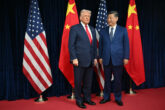August 25, 2019
The Balkans Will Pay a Heavy Price for China's Global Ambitions
Since President Xi Jinping announced the Belt and Road Initiative in Kazakhstan in 2013, framing it as an overland strategy to connect Asia to Europe, China’s inroads in the Western Balkans have grown more deeply entrenched. Through bridge construction projects in Croatia, investments in Bosnia’s energy infrastructure, and a bid to develop Serbia’s 5G networks, Beijing has turned the Balkans into a critical transitway as it tries to boost the export of its manufactured goods to Europe and grease the wheels of foreign direct investment into China. Its diplomatic and economic activities in the Balkans are divorced, however, from an understanding of the complex patchwork of ethnic, political, and historical legacies that define the region—so much so that it is likely to brew instability in an already rattled region.
China’s nexus in the Western Balkans is not without precedent. In the aftermath of the Second World War and failed rapprochement between the Soviet Union and Yugoslavia, Mao Zedong and Josip Broz Tito emerged as the region’s “communist mavericks.” Thus, began a tumultuous relationship between China and Yugoslavia as the two jockeyed for influence in Southeastern Europe while occasionally rallying against common rivals. China remained mostly neutral amid the series of ethnic conflicts in the early 1990s—including the ethnic cleansing of Bosnian Muslims—and wars for independence that accompanied the dissolution of Yugoslavia. After the 1999 NATO bombing of the Chinese embassy in Belgrade, however, the People’s Republic of China publicly reengaged with a $300 million infrastructure aid package. Today, China’s presence in the Western Balkans is most strongly felt in Serbia, where Beijing has established a strategic foothold.
Read the full article in The National Interest.
More from CNAS
-
Indo-Pacific Security / Energy, Economics & Security
How to Win the Economic War with ChinaTrump's approach to China has run aground, giving Beijing unprecedented advantage in the economic conflict....
By Edward Fishman & Julian Gewirtz
-
America’s Self-Loathing Is a Losing Hand
This article was originally published in The Washington Post.Around 10 years ago, the United States began a historic shift in its grand strategy toward China, abandoning the b...
By David Feith
-
Indo-Pacific Security / Energy, Economics & Security / Technology & National Security
Selling AI Chips Won’t Keep China Hooked on U.S. TechnologyU.S. policy should not rest on the illusion that selling chips can trap China inside the American tech ecosystem....
By Janet Egan
-
Will New Delhi-Beijing Move Beyond Friction Points? | Ex-White Official On India-China Reset
Prime Minister Narendra Modi on Friday said that India and China, as two major economies, must work together to bring stability to the global economic order. NDTV's Gaurie Dwi...
By Lisa Curtis




